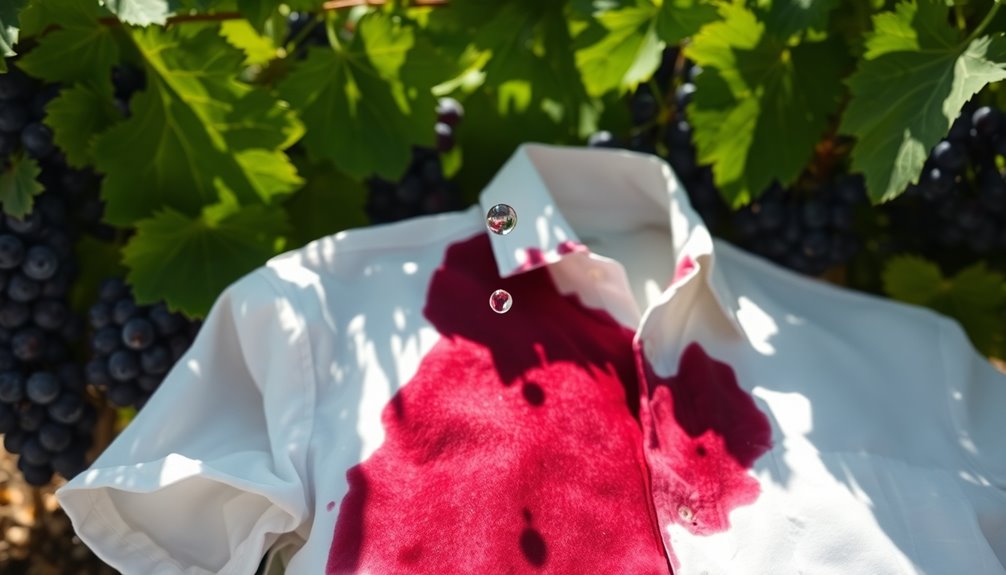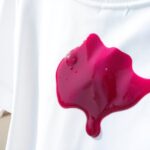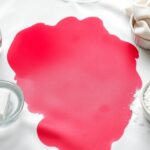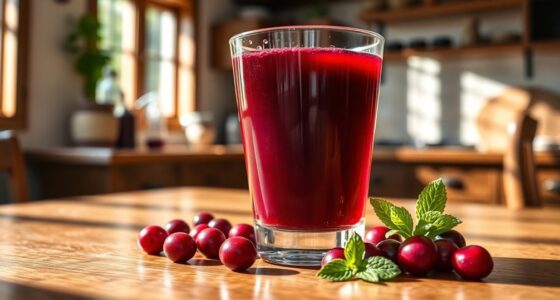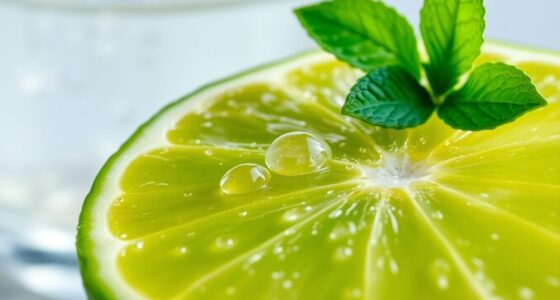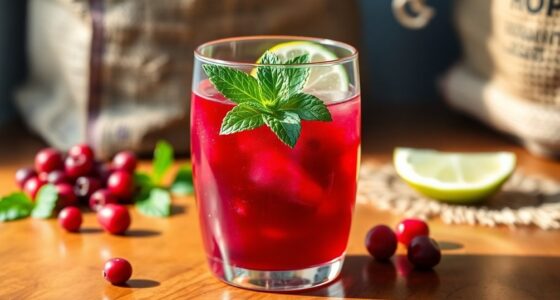To get grape juice out of white clothes, act quickly! Rinse the stained area under cold water from the back to push the juice away. Apply a stain remover or a baking soda paste and let it sit for 15 to 30 minutes. Wash the fabric in hot water safe for it, using a suitable detergent. Always check for remaining stains before drying; if needed, repeat treatments. Keep going to discover more effective tips!
Key Takeaways
- Rinse the stained area under cold running water immediately, starting from the back to push the juice away from the fibers.
- Apply a stain remover or a baking soda paste directly to the stain and let it sit for 15 to 30 minutes.
- Wash the garment in the hottest water safe for the fabric, using an appropriate laundry detergent.
- For stubborn stains, use a mixture of hydrogen peroxide and dish soap, then launder again after treatment.
- Always check the garment for remaining stains after washing; repeat treatment if necessary to ensure complete removal.
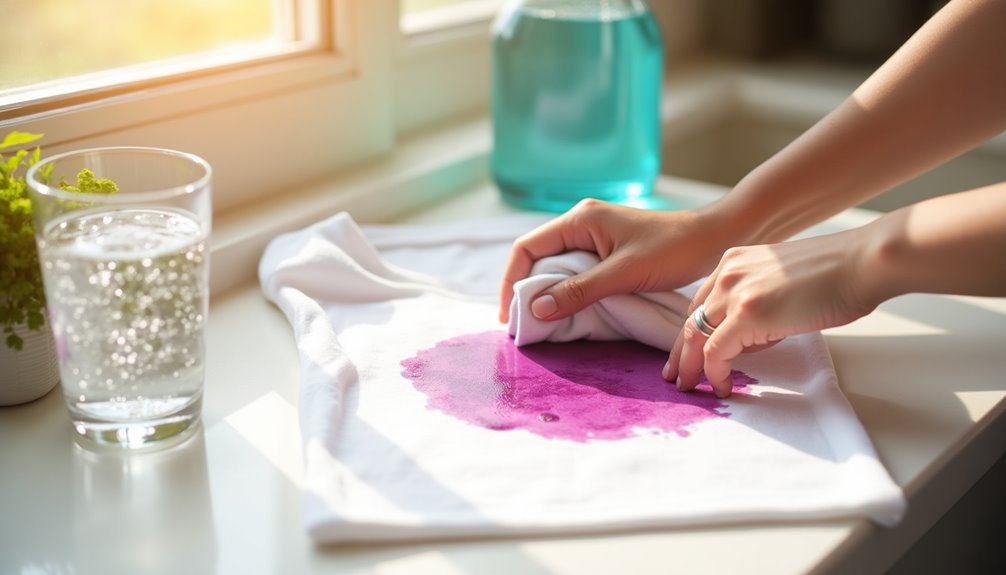
Grape juice stains on white clothes can be a real headache, but with the right steps, you can tackle them effectively. The key is to act quickly. As soon as you notice the stain, head to the sink. Rinse the stained area under cold running water. This helps dilute the grape juice and prevents it from setting into the fabric. Make sure to do this from the back of the fabric, pushing the juice away from the fibers instead of deeper into them.
Once you've rinsed the stain, it's time to pre-treat the stain. You can use a stain remover specifically formulated for whites, or you can create a simple baking soda paste by mixing baking soda with a little water. Apply your chosen cleaning solution directly to the stain, and let it sit for about 15 to 30 minutes. This will give the stain-fighting agents time to work on the grape juice.
For delicate fabrics, always check the care label first. If the fabric can handle bleach, applying a small amount can be quite effective. Follow the care label instructions for using bleach or opt for oxygen bleach, which is often safer for fabrics and still helps lift the stain. Just remember, the goal here is to remove grape juice stains without damaging your beloved garment.
After pre-treating, wash the garment in the hottest water safe for the fabric, using a suitable laundry detergent. It's important to check the garment's care label to ensure you're using the right temperature. Before you throw it in the dryer, inspect the stained area. If it's still visible, avoid drying it as the heat can set the stain, making it far more difficult to remove later.
If the stain has dried or is particularly stubborn, you might need to take extra measures. A mixture of hydrogen peroxide and dish soap can be a powerful solution. Apply this mixture to the stain and let it sit for a few minutes before laundering again. This added stain-fighting power can work wonders on tough grape juice stains.
After washing, don't forget to check the garment one last time. If the stain is still there, repeat the pre-treatment and washing steps until it's gone. Each time, remember to blot the stain with a clean cloth, never rub it, to avoid spreading the stain further.
Frequently Asked Questions
Does Grape Juice Come Out of White Clothes?
Yes, grape juice can come out of white clothes if you act quickly.
Rinse the stained area under cold water immediately to dilute the juice. Pre-treat the stain with a stain remover or a baking soda paste for 15-30 minutes.
Then, wash the garment in the hottest water safe for the fabric using a quality detergent.
Just remember to check for any remaining stains before drying, as heat can set them permanently.
Does Hydrogen Peroxide Remove Grape Juice Stains?
Imagine a stubborn stain clinging to your fabric like a bad memory.
Hydrogen peroxide can indeed remove grape juice stains. Its oxidizing properties break down the pigments causing the discoloration.
Mix equal parts hydrogen peroxide and dish soap, apply it to the stain, and let it sit for 15 to 30 minutes. Rinse with cold water, then wash the garment in the hottest water safe for the fabric to ensure a thorough clean.
Will Oxiclean Remove Grape Juice Stains?
Yes, OxiClean can effectively remove grape juice stains.
You'll want to apply OxiClean MaxForce or a similar stain remover directly onto the stain. Let it sit for about 5-10 minutes to break down the stain.
After that, wash the garment in the hottest water safe for the fabric. Just make sure to check the care label first, and avoid putting it in the dryer until you're sure the stain is gone!
Do You Use Hot or Cold Water for Grape Juice Stains?
When it comes to grape juice stains, you'd think hot water's a miracle worker, but it's the opposite!
Always stick to cold water. Rinsing with cold water dilutes the stain and stops it from settling deeper into the fabric.
Keep using cold water during the entire cleaning process, especially when applying any treatment.
You'll thank yourself later when that pesky stain doesn't become a permanent resident on your clothes!
Conclusion
In the battle against stubborn stains, grape juice on white clothes symbolizes life's little mishaps. But don't lose hope! Just as a painter restores a canvas, you can reclaim your fabric's purity with these simple steps. Treat the stain promptly, and let the power of common household items become your allies. Remember, every spill is just a chance to learn and grow, turning a soiled garment into a testament of resilience and care.
Cindy thoroughly researches juicing trends, techniques, and recipes to provide readers with practical advice and inspiration. Her writing style is accessible, engaging, and designed to make complex concepts easy to understand. Cindy’s dedication to promoting the advantages of juicing shines through her work, empowering readers to make positive changes in their lives through the simple act of juicing.

